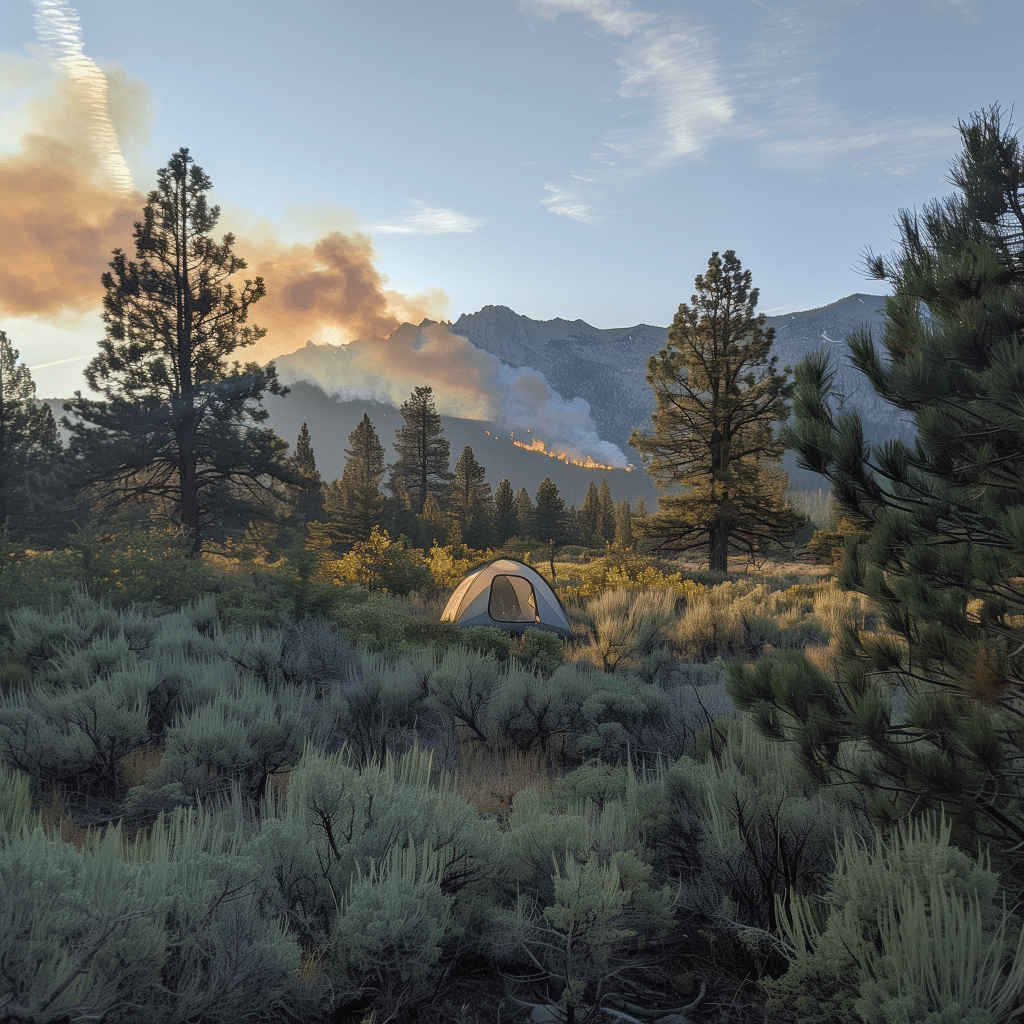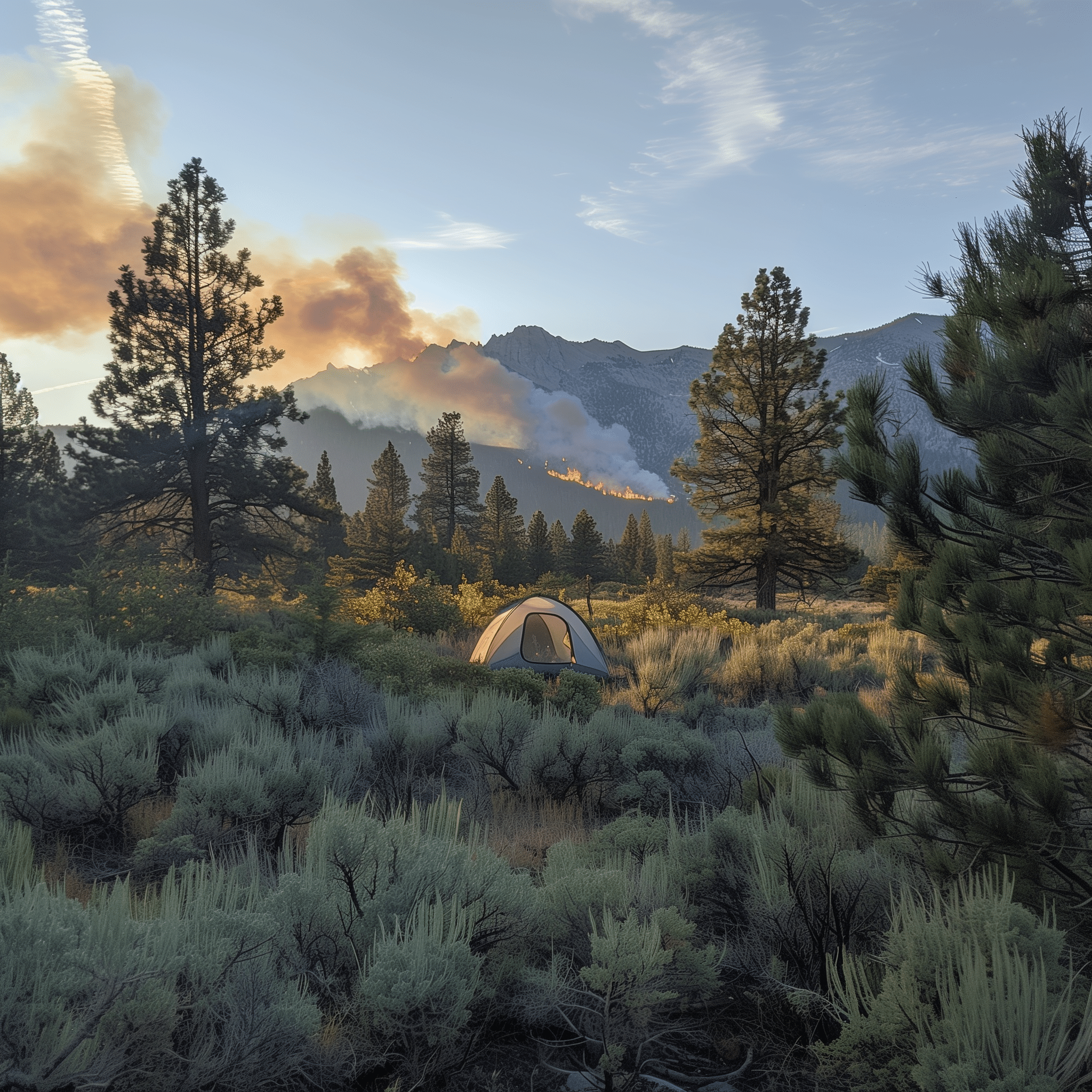
Camping brings the promise of tranquillity, adventure, and a deeper connection with nature. However, when your chosen retreat lies within the vicinity of a forest fire, even if it’s as far as 100 miles away, the stakes for safety and preparedness rise exponentially. In this guide, we delve into the crucial measures and tips for ensuring that your camping experience is not only enjoyable but also safe, even in the shadow of such daunting natural phenomena.
Understanding the Risks of Camping Near a Forest Fire Zone
Why Vigilance is Key: Even if a forest fire is dozens of miles away, wind patterns and rapid spread can change the situation overnight. Understanding the behaviour of forest fires and the conditions that affect their movement is essential for any camper in affected areas.
The Invisible Dangers: Beyond the flames, smoke and ash from distant fires can pose serious health risks, reducing air quality and visibility. Campers must be aware of the air quality index (AQI) in their chosen area and plan accordingly.
Preparing for Your Trip
Check Fire Activity and Restrictions: Before setting out, it’s crucial to check the current fire activity in the region and any fire bans or restrictions in place. This information can usually be found on the website of the local forest service or fire department.
Packing for Protection: In addition to standard camping gear, pack items that can help in a fire situation, such as N95 masks for smoke, eye protection, and a portable NOAA weather radio for updates.
Setting Up Camp with Safety in Mind
Choosing Your Campsite Wisely: Opt for a campsite that has natural barriers against fire, such as lakes or rivers. Avoid areas with dense, dry vegetation and be mindful of prevailing wind directions.
Creating a Safety Zone Around Your Camp: Clear away dry leaves, twigs, and other flammable materials from around your tent and cooking area. This defensible space can help prevent sparks or embers from igniting a fire at your site.
During Your Stay: Staying Informed and Ready
Stay Informed: Keep a charged device with internet access to receive updates on the fire situation. A battery-powered or crank radio can be invaluable in areas with poor cell reception.
Plan Your Evacuation Route: Know at least two exit routes from your camping area. In case of an emergency, having predetermined evacuation routes can save precious time.
Dealing with Smoke and Poor Air Quality
Protecting Yourself from Smoke: If smoke from a distant fire affects your camping area, stay inside your tent or vehicle as much as possible, and wear an N95 mask when outside. Keep hydrated to help your body deal with the smoke.
When to Call It Quits: Sometimes, the best decision is to pack up and leave for a safer area, especially if air quality worsens or if you or your camping party begin to experience health issues from the smoke.
Leaving No Trace Behind
Fire Safety Practices: Use established fire rings for campfires, keep fires small, and never leave a fire unattended. In areas under fire restrictions, use portable camp stoves instead.
Respect Fire Bans and Restrictions: Adhering to fire bans and restrictions is not only a matter of legal compliance but also a critical part of being a responsible member of the outdoor community.
Essential Gear List for Camping Near a Forest Fire Zone
- Safety and Navigation:
- Maps and Compass – Always carry physical copies in case of electronic failures.
- GPS Device – Useful for navigating unfamiliar territories.
- Multi-Tool or Swiss Army Knife – For cutting, repairing gear, and other miscellaneous tasks.
- Headlamp with Extra Batteries – Essential for navigating and tasks in the dark.
- First Aid Kit – Tailored to your group’s size and trip length, with additions for smoke and minor burn treatment.
- Whistle – To signal for help in case of emergency.
- Fire Extinguisher (small, portable) – A must-have for immediate response to small fires.
- Communication:
- Fully Charged Cell Phone with Portable Charger – For emergency calls and updates.
- NOAA Weather Radio – Battery-powered or hand-crank, for real-time weather and fire updates.
- Satellite Messenger or PLB (Personal Locator Beacon) – For emergency situations where cell service is unavailable.
- Protection from Smoke and Fire:
- N95 Respirator Masks – To filter out smoke particles and protect respiratory health.
- Goggles – To protect eyes from smoke and particulate matter.
- Fire Retardant Clothing (optional) – Clothes made from materials that resist ignition.
- High-Visibility Jackets or Vests – To ensure you are visible through smoke or to rescuers.
- Shelter and Comfort:
- Tent with Rainfly – Provides a safe haven from the elements and some protection from ash.
- Sleeping Bag and Pad – Choose according to the season for appropriate warmth.
- Tarps or Shelter Cloths – For extra protection against ash and light embers.
- Hydration and Nutrition:
- Water Filter/Purifier – Essential if you’re sourcing water from the wild, as water sources may be contaminated by ash.
- Water Bottles or Hydration System – Ensure you can carry ample water.
- Non-Perishable Food – Enough for your trip plus extra days, in case you need to stay put or evacuate slowly.
- Cooking and Fire Management:
- Portable Camp Stove – Preferable to open fires in high-risk areas.
- Fuel for Stove – Ensure you have enough for your trip.
- Fireproof Matches/Lighter – Even if you plan not to make a fire, having the means to create one in an emergency is crucial.
- Cookware (lightweight, easy to clean) – For preparing meals.
- Personal Items:
- Sunscreen and Lip Balm – To protect against the sun and dry conditions.
- Insect Repellent – To keep bugs at bay, especially in wooded areas.
- Personal Hygiene Items – Biodegradable soap, toothbrush, toothpaste, and a small towel.
- Waste Bags – To pack out trash and minimize impact on the environment.
- Miscellaneous:
- Notepad and Pencil – For notes, directions, or leaving messages.
- Duct Tape – For quick fixes and repairs.
- Cash – In case electronic payment systems are down in nearby areas.
- Identification and Important Documents (in a waterproof container) – In case of evacuation or emergencies.
Preparation and Awareness:
Before heading out, familiarize yourself with the use of each item on your gear list, especially safety and navigation tools. It’s not just about having the right equipment but knowing how to use it effectively. Stay informed about the conditions of your camping area, communicate your plans with someone who’s not on the trip, and always have an evacuation plan in place. Your gear is your lifeline, but your knowledge and preparedness are equally crucial for a safe camping experience.
FAQ
How can I check the current fire activity in the area I plan to camp in?
- Visit the website of the local forest service, fire department, or a national fire activity resource like InciWeb for up-to-date information on wildfires.
What are the essentials for camping in a forest fire-prone area?
- Essentials include N95 masks, eye protection, a portable NOAA weather radio, a first aid kit, ample water, and non-perishable food items.
How does smoke from a distant forest fire affect camping?
- Smoke can reduce air quality, and visibility, and can pose health risks, especially to individuals with respiratory conditions. It’s essential to monitor air quality and take precautions such as wearing N95 masks.
Is it safe to have a campfire in a forest fire-prone area?
- It’s crucial to adhere to local fire restrictions and bans. If campfires are allowed, use established fire rings, keep fires small, and never leave them unattended.
What should I do if the forest fire situation near my camping area worsens?
- Stay informed through local news or weather radio, follow any evacuation orders immediately, and have an evacuation plan in place before the situation worsens.
How can I minimize my impact on the environment while camping near a forest fire zone?
- Practice Leave No Trace principles, adhere to fire bans and restrictions, and ensure all fires are completely extinguished before leaving the campsite.
Conclusion
Camping near a forest fire zone demands a heightened level of awareness, preparation, and respect for nature’s power. By staying informed, equipped, and ready to act, campers can enjoy the great outdoors while minimizing risks to themselves and the environment. Remember, the beauty of nature comes with responsibilities, and by adhering to safety guidelines, we can ensure that these natural treasures remain for generations to come.






Leave a Reply